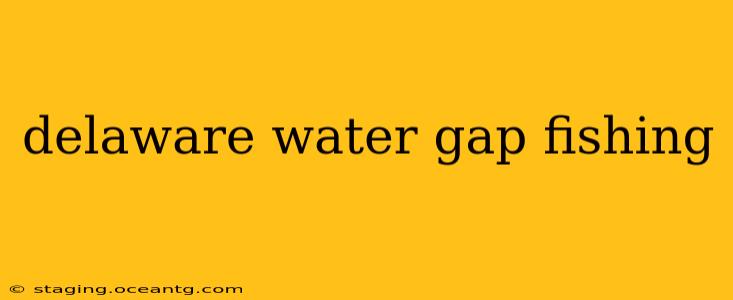The Delaware Water Gap National Recreation Area offers an angler's paradise, boasting pristine waters teeming with diverse fish species. Whether you're an experienced angler or just starting out, this guide will equip you with the knowledge to make the most of your fishing trip to this scenic location. From understanding the best fishing spots and techniques to complying with regulations, we'll cover everything you need to know for a successful and enjoyable experience.
What are the best fishing spots in the Delaware Water Gap?
The Delaware Water Gap offers a variety of fishing spots, catering to different preferences and skill levels. The Delaware River itself is a prime location, with its diverse habitats supporting various fish populations. Specific areas like the sections near Milford, Pa., and Matamoras, Pa., are known for good fishing. Look for areas with varying depths, currents, and cover, such as fallen trees or rocky shorelines. Additionally, several smaller tributaries and lakes within the National Recreation Area also provide excellent fishing opportunities. Remember to always check for current fishing regulations and access points before heading out.
What kind of fish can I expect to catch in the Delaware Water Gap?
The Delaware Water Gap boasts a rich diversity of fish species. Common catches include smallmouth bass, largemouth bass, channel catfish, rock bass, sunfish, and trout (depending on the season and location). The river's diverse ecosystem supports these populations, and skilled anglers may even encounter rarer species. Researching the specific species prevalent in your chosen fishing spot will help you choose the right bait and tackle.
What is the best time of year to fish in the Delaware Water Gap?
The ideal time to fish in the Delaware Water Gap depends on the target species. Spring and fall generally offer pleasant weather and excellent fishing conditions for many species. Summer can be hot, but early mornings and evenings are often productive. Winter fishing is possible, but ice and cold temperatures can make it challenging. Consulting fishing reports and local knowledge will provide up-to-date information on seasonal fishing activity.
What are the fishing regulations in the Delaware Water Gap?
Before you cast your line, familiarize yourself with the fishing regulations within the Delaware Water Gap National Recreation Area. These regulations are in place to ensure the sustainability of the fish populations and protect the delicate ecosystem. Regulations include license requirements, size and bag limits for specific species, and restrictions on fishing methods. You can find the most up-to-date information on the National Park Service website or by contacting local park rangers. Failure to comply with these regulations can result in fines.
What is the best bait to use for fishing in the Delaware Water Gap?
The best bait will depend heavily on the species you are targeting. For bass, live bait such as minnows or crayfish can be highly effective. Artificial lures like spinnerbaits, crankbaits, and plastic worms are also popular choices. For catfish, try using stinkbait, chicken liver, or cut bait. Trout often respond well to flies, spinners, or small lures. Experimentation and observation are key to finding what works best on a given day and in a specific location.
What kind of fishing license do I need?
A valid Pennsylvania fishing license is generally required to fish in the Delaware Water Gap. Check the Pennsylvania Fish and Boat Commission website for the most up-to-date licensing requirements and regulations. Ensure you have the appropriate license before heading out to avoid any penalties. Specific regulations may apply depending on your state of residence.
Are there any guided fishing tours available in the Delaware Water Gap?
While I cannot provide specific links to commercial services, it's worth searching online for "guided fishing tours Delaware Water Gap" to find local businesses offering this service. Guided tours can be a great way to learn about the area's best fishing spots and techniques from experienced professionals. They can also provide access to equipment and tackle.
What should I bring on a fishing trip to the Delaware Water Gap?
In addition to your fishing license and tackle, remember essentials like sunscreen, insect repellent, appropriate clothing, a hat, plenty of drinking water, and a first-aid kit. Comfortable walking shoes are recommended, especially if you plan on hiking to access different fishing spots. Consider bringing a cooler to keep your catch fresh and a waterproof bag to protect your valuables from the elements.
Remember to practice Leave No Trace principles while enjoying the Delaware Water Gap. Respect wildlife, properly dispose of trash, and minimize your impact on the environment. With a little preparation and respect for the environment, you're sure to have a memorable and rewarding fishing experience in this stunning natural setting.
